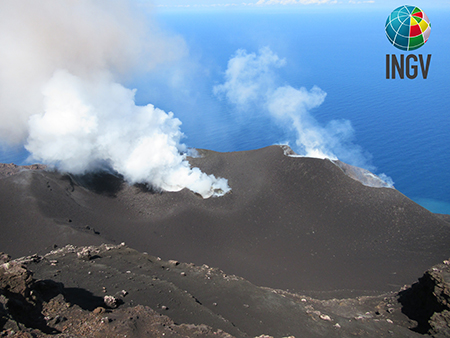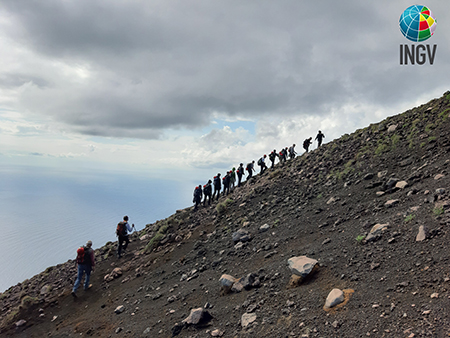 A class of high school students, a volcano already conquered and two others yet to be discovered. This is “Dynamic Mediterranean”, the School-Work Alternation Project activated by the “Lazzaro Spallanzani” State Scientific High School in Tivoli in collaboration with INGV and the Geology Section of the Science Department of Roma Tre University.
A class of high school students, a volcano already conquered and two others yet to be discovered. This is “Dynamic Mediterranean”, the School-Work Alternation Project activated by the “Lazzaro Spallanzani” State Scientific High School in Tivoli in collaboration with INGV and the Geology Section of the Science Department of Roma Tre University.
A dynamic and innovative experience that involves a high school with a consolidated vocation for geosciences: in fact, since 2010 the school has hosted a seismic station and since 2014 the "Renato Funiciello" Earth Sciences Laboratory, named after the great geologist as well as Director of Department of Geological Sciences of the Roma Tre University who died in 2009. The project combines field trips, to discover the most important volcanoes on the continent, with the educational path on geosciences carried out in the classroom by the students with Professor Luigi De Filippis during the whole school year. The first stop on this adventurous journey was Stromboli, the volcano of the Aeolian Islands where the boys went in the company of an exceptional companion, the INGV volcanologist Tullio Ricci who told us about this experience.
How did the idea of "dynamic Mediterranean" come about?
"Dynamic Mediterranean" is a project by Alternanza Scuola Lavoro that was born within a broader project of "Enhancement and orientation of Earth Sciences with geological-environmental curvature" presented to the MIUR in the 2018-2019 school year by the Headmaster of the Spallanzani High School, Lucia Cagiola. Both projects are born from the ideas and experiences of prof. De Filippis, geologist, who after obtaining his PhD at Roma Tre returned to teach Natural Sciences at Spallanzani. The high school's activities in the field of geosciences are the result of a multi-year collaboration with the Geology Section of the Science Department of the Roma Tre University and the various Lectiones Magistrales “Renato Funiciello” events organized over the years, which was also attended twice by the President of INGV Carlo Doglioni. From next school year, moreover, the lessons they will have a special guest, a European researcher who will be selected and sponsored every year directly by the EGU (European Geoscience Union).
What was the role of INGV in the project?
INGV was essentially the scientific partner. In particular, I - "external" tutor - and prof. De Filippis we evaluated which topics could be the most interesting for the class, helping to define a program that the students carried out in the classroom during the entire school year and which ended with an excursion to Stromboli from 12 to 16 April.
What are the fundamental objectives underlying the "dynamic Mediterranean"?
Definitely to make students interested in the study of geology and help them understand the importance that this discipline has, for example, in territorial planning choices and in the management and use of natural resources. But, also, to encourage the development of a solid scientific cultural basis for young people who wish to undertake a career in this field in the future and to encourage them to internalize an effective method of study and learning, based not only on theoretical study but also and above all on the development of a practical curiosity stimulated by laboratory and field activities.
Have you already participated, in the past, in other initiatives of this kind involving school children?
I had already done some activities in schools, mainly training interventions, seminars and short guided visits. Among these, I remember with pleasure one Lectio Magistralis entitled "Volcanoes: danger, risk and social aspects" held at the Liceo Spallanzani, organized as part of the days dedicated to prof. Renato Funiciello, point of reference during my doctorate carried out at the Roma Tre University with prof. Franco Barberi.
But an experience as demanding as a "school camp" of this type in Stromboli was really the first time.
How did you prepare for this “mission”?
Behind those 4 days of excursion there was a huge research work to identify which objectives could be really pursued and which to exclude, considering the destination and considering - clearly - also the continuous volcanic activity that characterizes Stromboli: we have selected the routes that guarantee the children the greatest possible safety, we have constantly checked that there were no variations in the activity of the volcano that could cause concern and a guide was chosen and following the best practices, Giuseppe De Rosa, geologist, former researcher and volcanological guide today, a person who knows the island very well and, above all, the volcano.
How did the visit to Stromboli go?
The visit was unfortunately characterized by bad weather. We left Rome on Friday 12th April and arrived in Stromboli at dawn on Saturday 13th: we should have climbed the volcano in the afternoon but, once we met Giuseppe De Rosa, we agreed that it was better to postpone until more favorable weather conditions. Our guide therefore took the opportunity to explain to the boys what we would do the next day, what the times would be and what we would see. We also used the afternoon to carry out a small test on the physical fitness of the boys: I guided them along the San Vincenzo nature trail which climbs up to 300 meters above sea level, arriving after two hours as far as the Sciara del Fuoco, or that morphological depression which houses the active craters and characterizes the Stromboli volcano, and into which the lava flows flow. Not even there, between low clouds, strong winds and a little rain, we were able to admire the actual volcanic activity. On the second day, due to the persistence of adverse weather conditions, we started the day at the INGV Volcanological Information Center in Stromboli, where I showed the kids some videos of the latest eruptions and where they were able to visit the exhibition area, retracing, with panels , the geological history, the danger and the volcanic activity of the island; after that we went for a "walk" to the beach of Forgia Vecchia. On the third day, we finally managed to climb the volcano.
What kind of paths were these?
The naturalistic path that we walked on the first day is a fascinating and continuous up and down that lends itself, on the way back, to a small stop in a typical pizzeria in Punta Labronzo, from which you can generally appreciate the volcanic activity: we, like I was saying before, we were a little unlucky because of the bad weather which greatly reduced visibility. Instead, the ascent itinerary that reaches the top of the volcano follows a route that starts from an altitude of 80 meters above sea level and, in just over 3 hours, leads up to 920 meters above sea level. In both cases, however, every 20-30 minutes we made brief stops to explain to the boys what they were seeing at that moment, what they were trampling on and what they should expect, but also to respect the natural needs of the body related to the ascent of a mountain of 900 meters.
Have you had any feedback from the guys?
I'll tell you an episode. The second day on the island, after being at the INGV Information Center, I took them to the beach of Forgia Vecchia: you can get there without a real path, with some stretches where you have to venture into the rocks. Once you arrive, you find yourself in front of a very particular, almost lunar landscape. Well, I heard someone say to the partner: "This is the coolest thing I've ever done in my life." I would say that it is a great feedback, considering that the climb to the craters was still missing, which also made me think: it was the first time I went to Stromboli with such young guys, when I go for work I am usually alone or accompanied by other researchers . I've climbed over 400 times, but this experience with them made me re-taste that ecstasy, that feeling of awe of the volcano that clearly is truly overwhelming when you meet it for the first time.
What will be the next steps of “Dynamic Mediterranean”?
The next step will be a visit to a scientific laboratory of the Rome branch of INGV, which the students will do right at the beginning of the next school year: this visit will close the circle of the "first phase" of "Dynamic Mediterranean". After which the project, which lasts three years, includes visits to two other volcanoes and two other scientific laboratories of the Institute. As for the volcanoes, at the moment we already know that next year we will visit Vesuvius and the Campi Flegrei, while the very last destination is still to be defined but the range of options is decidedly remarkable: we will have to choose between Etna, Lanzarote, Tenerife and the Iceland.
Would you like to dedicate yourself to other projects of this kind in the future?
The cohesive and interested group that I have brought to Stromboli this year makes me think that I would gladly do it again. I would also add, however, that with volcanoes it's a bit "you like to win easy": I challenge anyone to remain indifferent in front of an active volcano that "explodes" in front of your eyes every five minutes!
When you work with young people, what would you like them to have left of the volcanologist Tullio?
What a good question! The enthusiasm, certainly, and the pleasure I have in passing on my knowledge to people who find themselves walking on a volcano for the first time, teaching them to face it with due respect and with the awareness of being in a special place .



